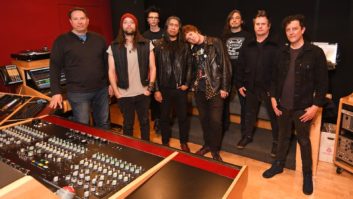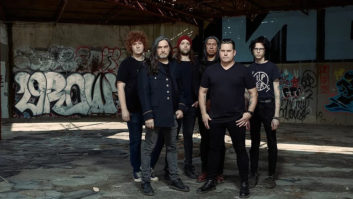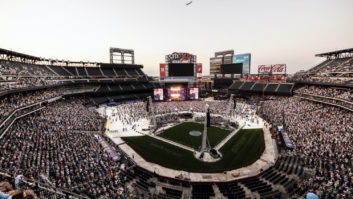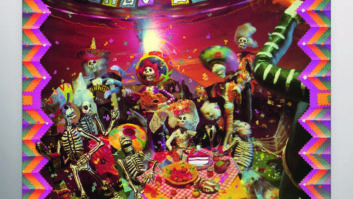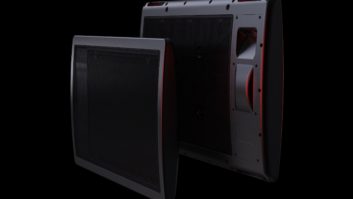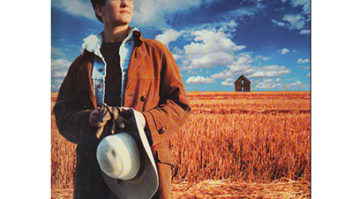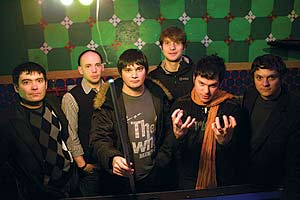
From left: Kevin Allen, Aaron Ford, Conrady Keely, Clay Morris, Jason Reece and Jay Phillips
Photos: Roger Kisby
As if their name — …And You Will Know Us by the Trail of Dead — isn’t enough, this Austin, Texas-based sextet’s seventh album was built on a trail of oddities and absurdities bizarre enough to fill a painting by 16th-century horror master Hieronymus Bosch. The Century of Self (Richter Scale/Justice) was (a) wrestled away from the group’s original producer, (b) tracked at four different studios, (c) recorded to tape/Nuendo/Logic/Pro Tools/tape, (d) partially inspired by a misery-inducing tour with a Cartoon Network band and (e) spooked by a ghost that inhabited the final studio’s underground passageway.
But wait, there’s more.
“The themes of the record involve prophecy, higher spirituality, childhood and how the world has been changed by consumerism,” multi-instrumentalist/vocalist Conrad Keely says. “The future fascinates me.”
Keely and fellow multi-instrumentalist Jason Reece migrated from Washington state to Austin in 1994, surrounded themselves with similarly minded art rockers and took on their impossibly long moniker. Albums such as Source Tags & Codes (2002) and prog-rock opera Worlds Apart (2005) cemented their cred with their fan base while alienating record labels. (Interscope dropped them in ’06.) The Trail of Dead sound is built on pure kitchen-sink tactics — Keely and Reece piling on melodies and instruments in seemingly scattershot fashion. But when you least expect it, a gorgeous melody will claw its way to the top, and it all makes sudden sense.
Initial tracking for The Century of Self began with producer Mike McCarthy in Austin, but after a disagreement, the band transferred files to a Venus VS3 hard drive and relocated across town to Bubble Recording and engineer Chris “Frenchie” Smith (Jet, Meat Puppets). Overdubbing on the original drum, scratch guitar and vocal tracks at Bubble, the band soon changed gears again and enlisted New York producer/engineer Chris Coady (TV on the Radio, Yeah Yeah Yeahs, Grizzly Bear) to work with them on fresh tracks at Mission Sound Recording (Brooklyn, N.Y.) on their Neve 8026/ Pro Tools HD3 Accel/Mac Intel dual-quad 2.8GHz system. Finally, TOD pursued further recording and mixdown at Coady’s DNA Studio in New York’s East Village.
“Tracking to another engineer’s rough mix is one of the most cruel and savage ways to do any kind of labor on a record,” Smith explains. “But it didn’t piss the band off; it was punk rock! It varied song by song, but there would always be a drum track and at least a pretty raging bass track. The previous engineer — God bless him — didn’t feature the rougher elements that much so we were able to fill in the blanks, and that shaped the future of how we worked.”
Recording to Bubble’s MCI JH-16 24-track 2-inch machine via a Neotek Elan II 32-channel console into Steinberg Nuendo, Smith functioned as both engineer and cheerleader.
“The two are quite different,” Conrad explains, regarding the record’s two engineer/producers. “Frenchie is hyperactive and he’s a great coach. Chris likes to think things through; he is more methodical and intellectual. And he is also really into noisy experimentation. If you give him a basic track, he wants to do something very abstract with it.”
After tracking at Mission Recording with Coady, Smith transferred the files — still on the now problematic Venus hard drive — to his DNA Studio (32-channel SSL E 6000 Series console with G modules/Apple Mac G5/Pro Tools HD/Logic 8), which features some truly brilliant pieces such as a vintage WWII-era Federal Television Corporation AM-864-U tube compressor, Audio Design Recording Compex Limiter F760X-RS (the drum sound of Led Zeppelin’s “When the Levee Breaks”) and an E.A.R. 660 limiting amplifier. These are Coady’s go-to compressors for drums and vocals. Coady also loves the Phil Spector wall of reverb approach, which he vigorously applied to The Century of Self‘s epic tracks.

Producer Chris Coady at the SSL E 6000 Series board in his DNA Studio (New York City)
“There are a lot of elements in TOD’s music that are particularly chaotic,” Coady says, “and points in the songs where for it to be confusing is the goal. Washing everything out in Audioease Altiverb and making things blend together made it more difficult to hear what is what. That was used as a means of making it more disorganized when the arrangement called for it. In ‘Isis Unveiled,’ for example, we were referencing the ’90s shoe-gazing bands by making it all one big wall of sound.”
Coady’s desired approach sounds challenging enough, what with the various generations of recording that preceded his involvement, but he also had to tackle some unfriendly EQ.
“Technically it was a headache,” he explains, “and having to understand another producer’s vision and dealing with heavy EQ on some tracks. As the tracks changed direction, the previous EQ and compression no longer applied. I used a Thermionic Culture Vulture to change things as needed. If you are missing some low mids in a sound, you can use EQ to boost it, but if it’s not there, then you are boosting nothing. With the Culture Vulture, you can create those frequencies. The Empirical Labs Distressor also does a fantastic job of giving you extra harmonics and additional body to the sound.”
Coady also dealt with TOD’s penchant for clashing sounds, something he generally favors, depending on the situation.
“The band’s drummer hits very hard, so the drums were loud and clear,” Coady comments. “I used a little compression and Culture Vulture on the drums. But part of TOD’s sound is that there’s a lot of crash cymbals and shredding guitars, often at the same time. Sometimes it was hard to get it to be listenable. Their earlier work is just like that; it’s a tradition. It’s very aggressive in the mids, and when you add it all up it becomes very midrange-y. Eventually, I stopped fighting it.”
While Coady worked out the kinks in DNA’s control room, Keely was having a ball out in the smallish live room playing with soft synths via his Apple Logic Studio/MacBook Pro system.
“On this album, I sequenced the demos of each song in Logic as far as I could go,” Keely recalls. “Once we rehearsed the songs and tracked them, from the live track I built a tempo map in Logic, which flowed with the natural tempo changes in the song and the performance. Then to that tempo track I synched up samplers or oscillators or arpeggiators.
“I really love the Sculpture soft synth in Logic,” he continues. “I would like to see it as an actual instrument. It offers wood, glass, nylon and steel for base sounds. And its Randomizer is great; you can get the sound of a marble bouncing along on a glass table. I also used the East West Symphonic Orchestra; it’s a total of 80 gigs of orchestra samples divided between the sections of the orchestra. The horns are velocity mapped so when you hit them you get this incredible blare. All the horns on the album are from that.”
Coady tracked guitar, keyboards, piano (an old Rudolph Wurlitzer upright) and drums at DNA. Signal chains included Neumann U67 and Shure SM7 mics into Neve 1066 or 1073s for vocals; Shure SM57, Coles 4038 or Royer R-121s into the Neves for guitars; and Coles 4038, Sennheiser 421 and AKG 414s, again with the Neves, for drums. Finally, Coady was assigned the task of mixing what sounds like one unholy mess of a record.
“When there is an abundance of elements,” he explains, “you can go through and surgically EQ things and make them sit together so you can hear everything clearly. But for me, having frequencies that overlap within the instruments is acceptable. Having things cancel each other out sounds more like real life. Just making sure that you have the bottom, middle and top frequencies ensures a big sound. And everyone wants the vocals to be clear; that is when I used the Federal compressor.”
Ultimately, the band’s chaotic recording process was a blessing in disguise. Like some kind of primal-scream therapy, The Century of Self‘s wall of noise and dense songcraft reflects the band’s working methods better than any of their previous recordings.
“We may have spliced different takes together,” Keely says, “but for the most part tracking was painless. We’ve had some excruciating times recording tracks in the past, not to mention our last tour. In the U.S., we opened for crowds that weren’t happy to see us — they came for a band from Cartoon Network called Death Clock Metalocalypse. The crowds were so hostile we would respond by making noise for 20 minutes. Just confronting them with a wall of noise turned into some of our best shows ever. I took those ideas to write songs for the record.”
Keely was also inspired by the 1877 book Isis Unveiled: A Master-Key to the Mysteries of Ancient and Modern Science and Theology, written by Russian mystic Madame Blavatsky.
“We are living in times of great change,” Keely muses. “My song, ‘Isis Unveiled,’ is written from the point of view of God and Lucifer, then Jesus ascending into Heaven. Madame Blavatsky’s Isis Unveiled was an indictment of science and religion, how they missed the point of spirituality. She influenced people like Edgar Cayce, the Sleeping Prophet.”
Coady’s DNA Studio has its own mystic being, a floating, foggy presence with no apparent means of escape. Talk about ghosts in the machine.
“She’s a ghost that lives in the studio hallway,” Coady says. “I’ve seen her, Conrad felt her presence and my studio partner has seen her. She has long hair and doesn’t appear to be miserable. But she’s trapped in the hallway forever, it seems.”
